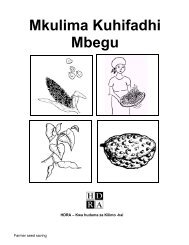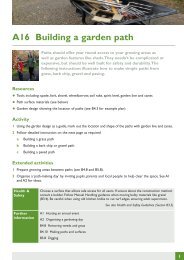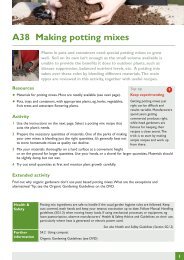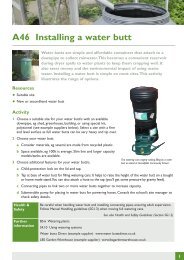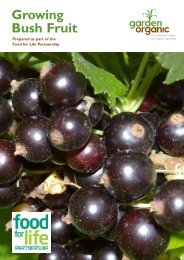Download PDF - Garden Organic
Download PDF - Garden Organic
Download PDF - Garden Organic
Create successful ePaper yourself
Turn your PDF publications into a flip-book with our unique Google optimized e-Paper software.
http://www.gardenorganic.org.uk/organicweeds<br />
allelopathic effect and may reduce soil fertility, at least initially. The use of<br />
allelopathic cover crops in reduced tillage systems may provide additional weed<br />
control benefits. Winter rye grown to increase soil organic matter and protect the soil<br />
leaves a residue able to reduce weed biomass by over 60% (Barnes & Putnam, 1983).<br />
The effect of the build-up of crop residues on pests and diseases is not known but<br />
there are thought to be benefits.<br />
Non-ploughing systems range from shallow cultivations with discs or tines to directdrilling<br />
into the stubble or mulched remains of the preceding crop. Heavy-duty tines<br />
may be needed to break up stubble and avoid ploughing before drilling the next arable<br />
crop. Speed and depth of cultivation will have a major effect. The results also<br />
depend on soil and weather conditions (Measures, 2004). Many find it impossible to<br />
dispense with the plough routinely. In addition to the effect on weeds and weed<br />
control, the use of reduced cultivations may have implications for disease and pest<br />
control, and for nutrient cycling (Lampkin, 1998). Even where there is no tillage,<br />
drilling and natural weathering will cause some soil disturbance (Cussans, 1966).<br />
There will also be soil and weed seed movement due to earthworms. It is important to<br />
maintain a flexible approach based on crop, soil and weeds.<br />
Minimum cultivation techniques have been developed based on permanent raised<br />
beds (Zarb, 2002). Narrow beds are used that are the same width as the machinery to<br />
limit soil compaction.<br />
Ploughing is not suitable for semi-arid prairie soils in North America due to the risk<br />
of wind erosion (Cloutier et al., 2007). The aim of non-inversion tillage is to prepare<br />
a rough seedbed and maintain crop residues in the upper layers of soil. Wide blade<br />
(1.5–2.0 m) cultivators that operate at 7 cm deep were developed for these conditions<br />
in the 1930’s but required a powerful tractor and did not control weeds in wet<br />
conditions. Many growers now use field cultivators and rod weeders. A tine harrow<br />
weeder is used for post-emergence weed control<br />
The punch planting technique minimises soil disturbance prior to crop sowing<br />
(Rasmussen, 2003). After autumn ploughing the land is harrowed in April and may or<br />
may not be worked down again to a finer tilth. The crop seed is dropped into holes<br />
made with a mechanical dibber. The area is flame weeded just prior to crop<br />
emergence in much the same way as for a stale seedbed.<br />
A 2-year cultivation strategy has been developed in combination with non-inversion<br />
tillage (Melander, 1999; Melander & Rasmussen, 2000). In year 1, the inter-rows of a<br />
cereal crop are kept weed free with repeated use of a tractor-hoe that also stimulates<br />
seed germination and reduces the weed seedbank. In year 2, row crops are sown<br />
where the previous inter-rows had been while the previously cropped strips become<br />
the new inter-rows and are cultivated accordingly.<br />
Specialised drilling equipment is needed to cut through the crop residues and<br />
precision drilling may be impossible. Crop harvesting may also be more difficult. In<br />
the USA a subsurface tiller-transplanter has been developed that makes transplanting<br />
vegetables directly into plant residues possible (Giacchetti, 1997). It cuts through the<br />
surface residue and opens the soil allowing transplants to be dropped in. It can also<br />
be used where a cover crop has been grown and cut down.<br />
October 2007 10




